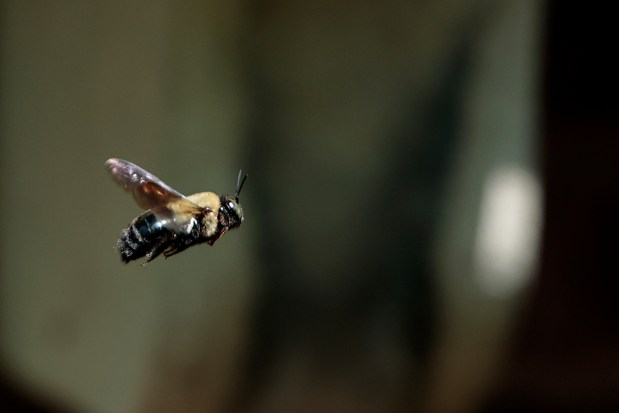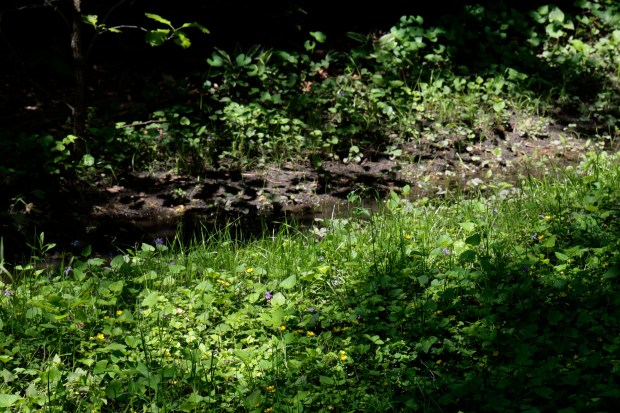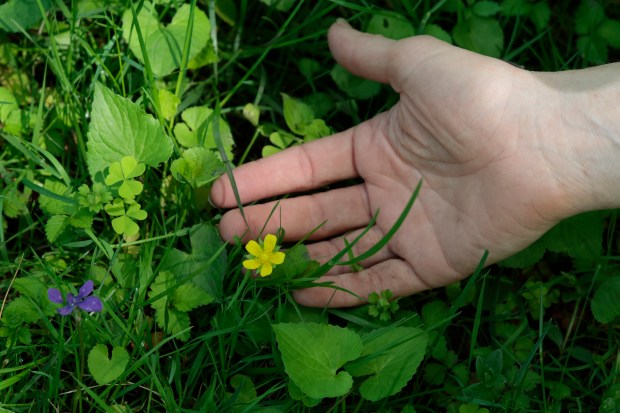The lawn in front of Annette Peterson’s Riverside bungalow stands maybe 2 inches higher than the standard emerald buzz-cut.
Look closely and you can see low-lying wildflowers — yellow, violet and lavender — hiding in the lush grasses.
Still, there’s little to suggest that Peterson is participating in No Mow May, a national conservation initiative that encourages homeowners to aid struggling pollinators, including bees, by forsaking the lawnmower until June 1.
Four years after No Mow May arrived in the United States, along with foot-high grasses and lawns dotted with hundreds of dandelions, there are signs that the Chicago area is embracing a more moderate approach.
At least five cities and towns in the area, including Westmont, La Grange Park and Riverside, are hosting No Mow ‘Til Mother’s Day, which allows lawns to grow and flowering weeds such as dandelions and creeping Charlie to fully flourish, but only until mid-May.
To supporters, it’s a win-win: Hungry bees get access to important early season pollen and nectar, and neighbors get more orderly vistas.
“I think it’s the perfect middle ground for suburban Chicagoland,” said Peterson, a yoga teacher.
The other participating communities include Glenview and Lombard, which had more than 650 participating households in 2023. Northbrook holds a similar program, Slow Mow May, in which participants mow every two to three weeks.
Local officials said that No Mow May, which started in England and was introduced in the United States in Appleton, Wisconsin, has been modified to account for the Chicago area’s fast-growing grasses.
“I grew up in this area. I’m very familiar with the ecology and grass,” said Jon Yeater, supervisor of the forestry and grounds division at the Westmont Public Works Department. “Even in an average year, I don’t think you can get through the entire month of May (without mowing).”
No Mow May is a response to growing concerns about declines in key insect populations, due to factors such as loss of habitat, climate change and pesticide use.
An influential 2017 study in the journal PLOS ONE found a 75% decrease in flying insects (by weight) in German nature preserves over 27 years, and in 2021 the National Academies of Sciences produced a special issue on insect decline, with the authors of one article writing, “Urgent action is needed on behalf of nature.”
Among the insects at risk are many North American native bees, according to the Xerces Society, a nonprofit conservation organization focusing on invertebrates, including insects.
The No Mow movement has sparked debate in recent years, with some critics saying that adding native plants to your yard or replacing your lawn entirely are more effective ways to support pollinators.
But supporters praise No Mow May for drawing attention to a hard-to-publicize issue, with Yeater saying No Mow programs get citizens involved and can lead to more ambitious home gardening practices.
“One of the things I like about it is it’s catchy, and people are finally starting to acknowledge that they can do something different with their lawns and it can have benefits for bees,” said Susannah Lerman, a research ecologist at the U.S. Forest Service and co-author of a frequently referenced 2018 study that found mowing less benefits bees.

“From that perspective, I think (No Mow May) is really great,” she said. “People are talking about it. You’re seeing (lawn) signs everywhere.”
Still, she said, May is just one month.
“If we can get people to reduce their lawn mowing in May — and June, July and August — then we’re talking. That’s going to have a lot more benefits for bees,” she said.
Her 2018 study found that mowing less frequently leads to more flowers and more bees. Lawns mowed every two weeks had the most bees (compared to lawns mowed every week or every three weeks). Among the possible explanations for the superior bee counts in lawns mowed every two weeks: the taller grasses in lawns mowed every three weeks may have impeded the bees’ access to flowers, the study said.
In Northbrook, which started with a full-blown No Mow May in 2021 but switched to Slow Mow May last year, sustainability coordinator Kate Carney said there were concerns that very tall grasses could crowd out flowers or block insects that burrow underground in winter and emerge in spring.
No Mow May programs — and the many variations — can help homeowners avoid fines, with towns often temporarily suspending enforcement of lawn-height ordinances.
Still, many No Mow May enthusiasts participate in towns without official programs, taking their chances with tickets, mowing occasionally, or confining their participation to backyards.

Retired special education teacher Kathleen Lojas said she mows her Brookfield front yard but lets the backyard “go meadowy” in May.
She has red clover, Dutch clover, creeping Charlie, dandelions and violets.
“I saw a great, big bumblebee the other day by my irises, and I was so, so happy,” she said.
Peterson said she mowed her front lawn once this spring at her husband’s suggestion, and she keeps the dandelions at bay, in part “to keep the neighbors smiling and waving happily.”
“I want to be responsive. I want to be a good neighbor,” she said. “But I also want to be a good steward of the environment.”
Mother’s Day strikes her as a great no-mow cutoff point, in part due to the nature of the holiday.
“I host my mother and in-laws and you want the place to be pretty. There’s this sense of I don’t know — propriety,” she said.

Lerman, the research ecologist, said she hadn’t heard of No Mow ‘Til Mother’s Day before, but she liked the idea: “What it says to me is that people are taking this idea of No Mow May, and they’re making it work for where they’re at.”
On a sunny day in early May, Peterson gave a tour of her ¼-acre property, where she lives with her husband and their two children in a 1926 brick bungalow.
The front yard included traditional purple irises, wild strawberries, a flower box and a birdfeeder. Big carpenter bees — yellow and fuzzy on top, and sleek and black below — hovered near the house.
The side lot and backyard, which were hidden from the street, won’t be mowed until June, Peterson said. There, the look was wilder, with lots of trees and a stream-like trench making its way through the violets and mock strawberry, toward a small temporary pond. Robins and cardinals sang as Peterson knelt to inspect a single purple violet.
With all the shade, the grasses hadn’t grown very high yet, she said apologetically. But the overall effect was still that of a woodland refuge.
Deer and ducks have stopped by, Peterson said, and two weeks ago she saw a coyote.
“Yards aren’t just for us, and we’re realizing that,” she said. “That’s the important shift that we’re seeing. We’re acknowledging that and we’re making room for all the inhabitants.”
nschoenberg@chicagotribune.com



